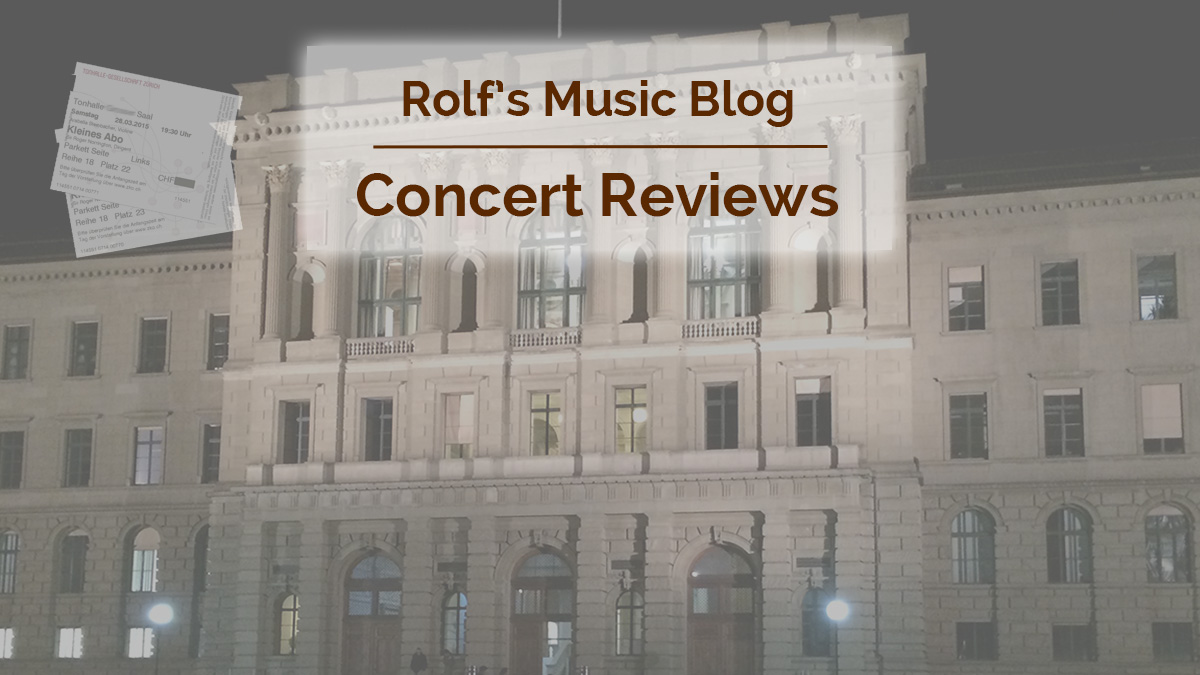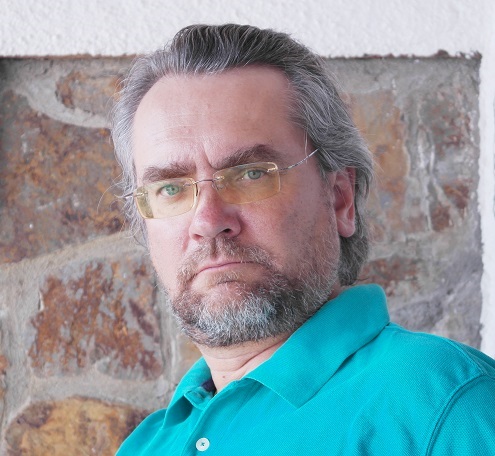Piano Recital: Konstantin Scherbakov
“Eroica” — Beethoven / Liszt
Semper-Aula, ETH Zurich, 2015-03-24

2015-03-26 — Original posting
2015-05-16 — Added link to latest CD
2016-08-03 — Brushed up for better readability
Table of Contents
- Introduction, Program
- The Artist
- Ludwig van Beethoven (1770 – 1827): 6 Bagatellen, op.126
- Bagatelle #1 (G major, Andante con moto, cantabile e compiacevole , 3/4 / 2/4)
- Bagatelle #2 (G minor, Allegro , 2/4)
- Bagatelle #3 (E♭ major, Andante, cantabile e grazioso , 3/8)
- Bagatelle #4 (B minor, Presto , 2/2)
- Bagatelle #5 (G major / C major, Quasi allegretto , 6/8)
- Bagatelle #6 (E♭ major, Presto , 2/2 — Andante amabile con moto , 3/8)
- Summary
- Beethoven: 15 Variations and Fugue in E♭ major, op.35
- Beethoven: Symphony No.3 in E♭ major, op.55, “Eroica” Transcription for the Piano by Franz Liszt (1811 – 1886)
- Conclusion
- CDs relating to this Concert
- Addendum
Introduction, Program
This was another concert in the series “Music at the ETH”, the Eidgenössische Technische Hochschule (Federal Technical University) in Zurich , in the “Semper Aula” (see the posting “Piano Recital Claire Huangci, 2015-02-10” for an earlier concert in the same series). The program featured three compositions, all originally by Ludwig van Beethoven (1770 – 1827):
- 6 Bagatellen, op.126
- 15 Variations and Fugue in E♭ major, op.35, “Eroica Variations”
- Symphony No.3 in E♭ major, op.55, “Eroica” — transcription for the piano by Franz Liszt (1811 – 1886)
The Artist
The artist was Konstantin Scherbakov, a pianist that I hardly knew before attending concerts of his most successful pupil, Yulianna Avdeeva, who studied with him in Winterthur / Zurich. She also was his assistant for a while. Konstantin Scherbakov was born 1963 in Barnaul, Siberia. He is the winner of the First All-Union Rachmaninoff Competition in Moscow, in 1983. His international career launched after four recitals at the chamber music festival in Asolo, in 1990. Since 1998 he is living near Zurich, Switzerland, but also spends time in Spain and in Russia. He is teacher at the ZHdK (Zürcher Hochschule der Künste) in Winterthur, and he is also pursuing a concert and recording career.
His recordings appear through Naxos. They include works by Nikolai Medtner, Ottorino Respighi, Dmitri Shostakovich, Sergei Lyapunov, the Tchaikovsky piano concertos, all of Beethoven’s symphonies in Franz Liszt’s transcription. Last, but certainly not least, he is in the process of recording all of Leopold Godowsky‘s piano works. His concert repertoire is substantially wider, spanning from the Vienna Classics to Ravel and Prokofiev. One of his most successful and most acclaimed recordings is that of the Beethoven symphonies. I have these on CD, I enjoy them a lot, and hence was looking forward to attending a live performance of the Symphony No.3! But first things first:
Ludwig van Beethoven (1770 – 1827): 6 Bagatellen, op.126
The concert (sold out in this small venue of around 100 seats) started with Beethoven’s 6 Bagatellen, op.126. These may sound like “six small warm-up pieces”. In Scherbakov’s hands, they turned into what they are: Beethoven’s final works for piano, published in 1825. Little masterpieces, not in the big form, but very much condensed in their means. These are not pieces for beginners. They have their distinct technical challenges, and they are not performed that often.
“Too much effort for too little outcome” in some artist’s mind, maybe? Even as encores they are too long and diverse in their entirety, yet typically too short as individual pieces. There are exceptions to this: I remember how in a concert in Aarau, Hans Richter-Haaser (1912 – 1980) once played the shortest of the Bagatelles (No.10 from op.119) as one of five encores. But this was just out of a very special situation: a concert in an almost empty venue.
Some pianists play all of op.126 with virtually no interruption, as one single (somewhat formless, but multi-faceted) piece. Konstantin Scherbakov played them all separately, which gave each of the Bagatelles much more weight. It almost enhanced each of them to a little universe, with its specific emotionality:
Bagatelle #1 (G major, Andante con moto, cantabile e compiacevole, 3/4 / 2/4)
This seemed rather slow at first. But that impression only lasted a few moments, then one felt immersed in a highly expressive, longing, somewhat melancholic piece of music. Scherbakov presented it with warm, full sound, with very distinct, delicate agogics, subtle dynamics, legato (even staccato notes were played rather portato), with a wonderfully singing tone.
Bagatelle #2 (G minor, Allegro, 2/4)
This is switching between rapid semiquavers and more lyrical cantabile sections. None of the rests between the rapid interjections were abrupt (partly because of Scherbakov’s subtle use of the sustain pedal, maybe supported by the acoustics of the venue, which enhances the bass register), such that the big phrases never got lost.
Bagatelle #3 (E♭ major, Andante, cantabile e grazioso, 3/8)
Maybe a little slow for an Andante (let alone Andante grazioso), but Scherbakov exposed the lyrical, singing aspects (hence focusing on the cantabile), adding little fermatas before a phrase reached its climax.
Bagatelle #4 (B minor, Presto, 2/2)
That’s the longest of the Bagatelles. Scherbakov made this a little more compact by only playing the first (out of three) repeats — understandable, given the length and intensity of the things yet to come! The two virtuosic B minor (played about as fast as the acoustics and the Steinway D permitted) sections are followed by rather bucolic, serene B major segments, rhythmically “suspended”, with syncopated “hurdy-gurdy” accompaniment and a “broken” singing melody, with rests on the first beat almost throughout. The omitted repeats (all B minor) gave more weight to those “pastoral” parts.
Bagatelle #5 (G major / C major, Quasi allegretto, 6/8)
A peaceful, lovely piece, with a canon-like rhythmic texture — the simplest Bagatelle in op.126, but with wonderful, long phrases.
Bagatelle #6 (E♭ major, Presto, 2/2 — Andante amabile con moto, 3/8)
This starts and ends with very fast Presto quaver-sections that end in a sequence of staccato chords. Scherbakov avoided all harshness in these chords, softening them with a little pedal. This way, the introduction did not run into a false ending, but seamlessly bridged the rest, leading into the Andante section: a very expressive piece that seemed to change between serene / bucolic and more melancholic, almost sad (yet beautiful) sections — until the composer firmly closes the composition with another, short Presto segment.
Summary
Scherbakov exposed the full depth of these six pieces, putting them in line with Beethoven’s most mature piano compositions. He played them as what they are: a key part of the composer’s legacy. It was a very touching, great interpretation: far from harmless, far from historically informed, maybe (after all, a Steinway model D was also beyond the composer’s imagination), but very impressive anyway, in its own right. Interestingly, the last Bagatelle ends in E♭ major — making an ideal transition to the following composition:
Beethoven: 15 Variations and Fugue in E♭ major, op.35
Next in the program were Beethoven’s 15 Variations and Fugue in E♭ major, op.35, also known as “Eroica Variations”. That name is actually wrong, because in 1802, when these variations were composed, the Symphony No.3 hadn’t been written yet. But the variations are based on a theme that Beethoven had already used in Contretanz (counter dance) No.7 (WoO 14), later in the ballet “The Creatures of Prometheus”, op.43. Finally, he was also going to use it in the last movement of the third symphony, op.55, called “Eroica”, hence the name.
These variations are probably comparable in importance to Beethoven’s opus summum in this genre, the 33 “Diabelli” Variations, op.120. Certainly, the theme in op.35 is more complex than Anton Diabelli’s simplistic theme with the “Schusterfleck”: the one in op.35 is infinitely more rewarding. It’s for good reason that Beethoven re-used and further developed the “Eroica” theme over and over again. On the other hand, it’s the triviality in Diabelli’s theme which challenged Beethoven and led him to write a full set of 33 Variations in op.120.
The Performance
The Variations op.35 start “slowly”, stepwise, first presenting the bass of the theme (Introduzione col Basso del Tema). Beethoven then adds a simple melody line (A due), then a third voice (A tre), then a fourth one (A quattro). Then only he introduces the full theme with the proper melody. After the Bagatelles, I did not expect a casual interpretation of op.35. And indeed, the lively agogics in the theme (Tema) made it clear that we were going to hear a highly engaged, expressive interpretation. Konstantin Scherbakov separated all variations by a little pause, but overall gave a balanced interpretation with respect to the tempo, avoiding extremes, both towards the slow and the fast side.
The op.35 is technically quite challenging. Beethoven must have written them for presenting his own virtuosity. Konstantin Scherbakov — being used to playing the highly virtuosic, late and post-romantic repertoire — of course had no problems with Beethoven’s score. He continued playing with his warm, full tone, supported by the acoustics. He still preferentially used legato, maybe with the amount of sustain pedal at the upper limit, playing con alcune licenze (i.e., with some freedom) in dynamics. But overall, the interpretation was compelling, internally consistent, maybe rather romantic, but still very convincing, for sure!
Beethoven: Symphony No.3 in E♭ major, op.55, “Eroica”
Transcription for the Piano by Franz Liszt (1811 – 1886)
After the intermission, there was a single point in the program: Franz Liszt’s piano transcription of Ludwig van Beethoven’s Symphony No.3 in E♭ major, op.55, “Eroica”. Liszt had started transcribing the third movement (Scherzo) in 1843. But only in 1863 he started a concerted effort to transcribe all nine of Beethoven’s symphonies. He finished that task in 1865.
Liszt’s Transcriptions on CD
These transcriptions have rarely been played in concert. More so, very few pianists have recorded the entire set of all nine Beethoven symphonies. I did a quick search on amazon and found the following, currently available sets:
- İdil Biret (*1941) for Naxos (6 CDs)
- Leslie Howard (*1948) as part of his complete Liszt recording for Hyperion (99 CDs)
- Cyprien Katsaris (*1951) for Teldec (6 CDs)
- Konstantin Scherbakov (*1963), also for Naxos (5 CDs), see below.
Other pianists, such as Glenn Gould (1932 – 1982) have recorded individual symphonies.
How Does a Transcription Sound?
Sound samples are available for Cyprien Katsaris‘ recording on amazon. I have checked the snippets for the “Eroica” transcription and found a very clear, very “pianistic” interpretation, seemingly trying to demonstrate Liszt’s ability to condense an orchestral score onto the piano, the pianistic means that Liszt was using. The focus seems to be on clarity and transparency.
I have listened to Konstantin Scherbakov‘s complete set (see below). That appears to be quite different. The Naxos sound engineering is somewhat dry and analytic. But Scherbakov’s interpretation to me is rather trying to pursue what must have been Liszt’s (and the publisher’s) intent with these transcriptions: to make Beethoven’s masterworks accessible to a wider audience. Consequently, the artist doesn’t appear to try reproducing / demonstrating Liszt’s piano score in every detail. He rather seems to orient himself in Beethoven’s original scores (through Liszt’s transcriptions, of course).
In the case of the Symphony No.1 in C, op.21, I even felt that Scherbakov’s interpretation must be influenced by the spirit of recent, historically informed performances of Beethoven’s symphonies. That impression wasn’t quite that strong in the case of the “Eroica”, but I’ll return to this topic below. In any case, Scherbakov’s recording of the “Eroica” transcription was made in 2001, and in the 14 years since, his interpretation may have undergone some changes. I found the concert performance to be quite in line with the CD recording, though the acoustics of the venue provided an entirely different environment. There was more reverberation, stronger basses, a warmer, full sound (less clarity, though). Also, the Steinway model D was maybe tuned a little better than the piano in the CD recording.
The Concert Performance
Let me discuss the individual movements in the concert performance briefly:
I. Allegro con brio
A gigantic movement: around 17 minutes of relentless, very complex and dense piano score, in a very captivating, enthralling interpretation. This really evoked the orchestral version at all times, let the audience sense the sound of the full orchestra. Scherbakov lived Beethoven’s (rather than Liszt’s) score, lived the “Eroica”, really, and he even did the repeat of the exposition! Both the physical effort, as well as the ability to memorize the 50 minutes of this score with its towering sound clusters are astounding, outstanding. In that perspective, the short memory lapse around bar 474 was absolutely negligible, particularly because the artist was able to overplay it. Many in the audience will not even have realized what happened.
II. Marcia funebre, Adagio assai
The tempo here was substantially below Beethoven’s metronome marks. In that sense, I could not say that this performance was “historically informed” (it’s a funeral march, after all). However, I can’t really criticize this here: I don’t know whether by 1863 / 1865 the romantic era had already slowed down the tempo in that movement to what we know from traditional performances in the first half of the 20th century. I also don’t know whether Liszt put any (or his own) metronome marks into the transcriptions. Last, but not least, I don’t know whether Beethoven’s metronome marks (which we now know to be largely correct / realistic) are doable on the modern piano at all. They may have been doable on Liszt’s pianos with lighter mechanics, though.
Despite the slow tempo, it was an impressive performance in this movement as well. In the piano score, the (over-)stretching of melodies by the slow pace wasn’t so noticeable (there weren’t any wind instruments running out of breath!). I now checked Cyprien Katsaris’ version: he is even (substantially) slower. But also at Scherbakov’s tempo, maintaining the tension over the 15 minutes of this movement is a real challenge, compared to a faster (orchestral) performance at Beethoven’s intended tempo. But it’s a challenge that Konstantin Scherbakov mastered very well in the live atmosphere of the concert.
III. Scherzo: Allegro vivace — Trio
This is a shorter movement (Scherbakov omitted the repeat of the Scherzo part), but nevertheless technically very demanding, with its relentless, full-chorded staccato sequences. What impressed me most here is, how the artist was able to evoke the full-sounding horn calls in the Trio, and the agility with which he played the intricate, syncopated chords in the Scherzo part.
IV. Finale, Allegro molto — Poco andante — Presto
This movement brought the return of the “Eroica” theme, which dominated the variations op.35, hereby nicely bracketing the concert evening. The introduction of the theme (first by the bass melody alone) is very similar to how it is done in op.35, but more compact, more mature, more complex. The movement evolves into a polyphonic masterpiece, with lyrical moments in-between. It was amazing to hear how Scherbakov was able to evoke the sound of the woodwinds (e.g., the singing of a flute), but also the full sound of a large body of string players. The audience was overwhelmed by the performance and delivered a well-deserved, standing ovation.
Summary
To me, the focus on this performance was, to create the atmosphere of an orchestral performance, rather than the ultimate clarity and instrumental perfection. Sure, there are limitations to what a piano can do. In particular, an orchestra can cover a much, much wider dynamic scope. On the other hand, there are also things which may be “easier” (if we may use this word in this context at all!). For example, a piano has more agility in agogics and rubato, where an orchestra may be stretched, running into coordination issues.
There may be limitations in the number of voices that a pianist can play with two hands. But here, I didn’t miss much of Beethoven’s score, and the transparency of the piano in this performance seemed at least as good as with a full orchestra. Overall, Liszt’s complex piano score leaves the listener in awe at what a pianist can do with only two hands. My neighbors commented that one often had the feeling that there were at least four hands playing!
Conclusion
This was my first live encounter with Konstantin Scherbakov in concert. Compared to his CD recordings, I found new aspects with this artist: the sound here was much warmer, more resounding than in the Naxos recordings. It also felt more legato, but that may have been the acoustics of the venue.
More importantly to me: for the past two decades the artist was mostly pictured with an earnest, maybe “Beehovenian” / titanic, somewhat closed facial expression. However, in the concert, which he presented with a mostly relaxed, yet controlled body language, his face hinted at a wealth of emotions. And his playing struck me as a prime example of the “big Russian Piano School”, with such eminent masters as Heinrich Neuhaus (1888 – 1964) and Emil Gilels (1916 – 1985). Particularly the latter comes to mind when I think about Konstantin Scherbakov’s performance last Tuesday. Yet, the interpretations of these two artists are quite different: Gilels’ almost excessive emotional depth vs. Scherbakov’s more balanced, “integrative” approach. Overall, it was a really memorable evening!
CDs relating to this Concert
Konstantin Scherbakov: Beethoven, Symphonies Nos. 1 & 3 in Franz Liszt’s piano transcription (part of the set below)
Franz Liszt: Beethoven, Symphonies Nos. 1 & 3, piano transcriptions
Konstantin Scherbakov, piano
Naxos 8.555354 (CD, stereo); ℗ / © 2001
Booklet: 8 pp. en/de/fr

Konstantin Scherbakov: Beethoven, Symphonies Nos. 1 – 9 in Franz Liszt’s piano transcription
Franz Liszt: Beethoven, Symphonies Nos. 1 – 9, piano transcriptions
Konstantin Scherbakov, piano
Naxos 8.505219 (5 CDs, stereo); ℗ 1998 – 2006 / © 2006
Booklets with the individual CDs, typically 8 pp., en/de/fr

Konstantin Scherbakov: Beethoven, 15 Variations op.35; Piano Sonatas opp.13 (“Pathétique”) & 57 (“Appassionata”)
Ludwig van Beethoven: 15 Variations op.35 (“Eroica”), Piano Sonatas opp.13 & 57
Konstantin Scherbakov, piano
Two Pianists Records TP1039190 (5 CDs, stereo); ℗ / © 2015

The Naxos CDs appeared as part of a project intended to cover all of Franz Liszt’s piano works, involving several artists.
Addendum
- Several recordings of the Variations op.35 were discussed in a the blog post Beethoven: “Eroica” Variations op.35
- Beethoven’s original version of the Symphony No.3, op.55 was discussed in several recordings, see the blog post Beethoven: Symphony No.3 in E♭, op.55, “Eroica”












